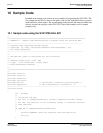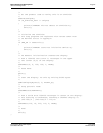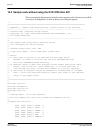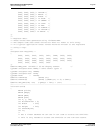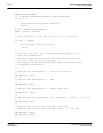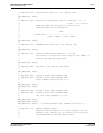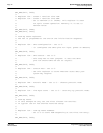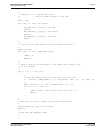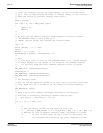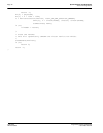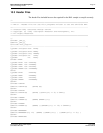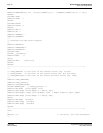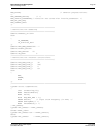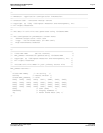
Page 74 Epson Research and Development
Vancouver Design Center
S1D13705 Programming Notes and Examples
X27A-G-002-03 Issue Date: 02/01/22
** Clear the display, and all of video memory, by writing 81920 bytes
** of 0. This is done because an image in display memory is not rotated
** when the switch to portrait display mode occurs.
*/
pMem = p13705;
for (tmp = 0; tmp < MEM_SIZE; tmp++)
{
*pMem = 0;
pMem++;
};
/*
** We will use the default portrait mode scheme so we have to adjust
** the ROTATED width to be a power of 2.
** (NOTE: current height will become the rotated width)
*/
tmp = 1;
while (Height > (1 << tmp))
tmp++;
Height = (1 << tmp);
OffsetBytes = Height * BitsPerPixel / 8;
/*
** Set:
** 1) Line Byte Count to size of the ROTATED width (i.e. current height)
** 2) Start Address to the offset of the width of the ROTATED display.
** (in portrait mode the start address registers point to bytes)
*/
SET_REG(0x1C, (BYTE)OffsetBytes);
OffsetBytes--;
SET_REG(0x0C, LOBYTE(OffsetBytes));
SET_REG(0x0D, HIBYTE(OffsetBytes));
/*
** Set Portrait mode.
** Use the non-X2 (default) scheme so we don't have to re-calc the frame
** rate. MCLK will be <= 25 MHz so we can leave auto-switch enabled.
*/
SET_REG(0x1B, 0x80);
/*
** Draw a solid blue 100x100 rectangle centered on the display.
** Starting co-ordinates, assuming a 320x240 display are:
** (320-100)/2 , (240-100)/2 = 110,70.
*/
for (y = 70; y < 180; y++)
{
/*
** Set the memory pointer at the start of each line.
** Pointer = MEM_OFFSET + (Y * Line_Width * BPP / 8) + (X * BPP / 8)
** NOTICE: as this is default portrait mode, the width is a power
** of two. In this case, we use a value of 256 pixels for
** our calculations instead of the panel dimension of 240.



